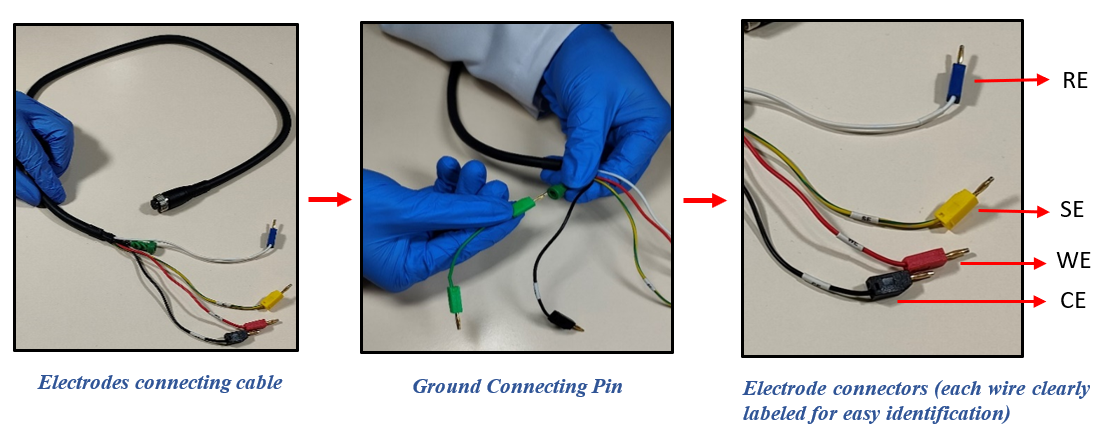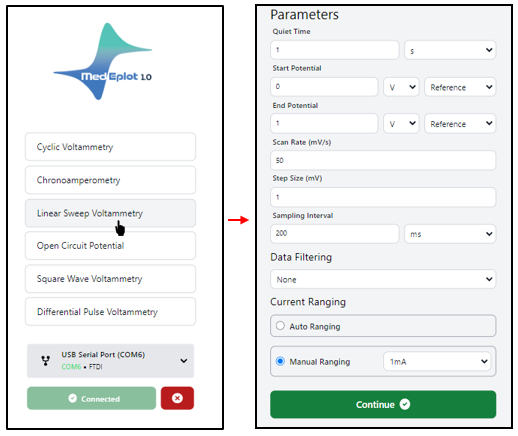This application note highlights the importance of grounding in electrochemical studies, particularly when using the MedPstat potentiostat. Many researchers tend to overlook this aspect, but proper grounding is essential for accurate results and safety. Grounding minimizes electrical noise, prevents measurement errors, and enhances low-current sensitivity, ensuring stable and reliable data in the experiments. It also reduces unwanted voltage drops, improving the accuracy of applied potentials and measured currents. Additionally, proper grounding enhances reproducibility, ensuring consistent results across different test conditions.

Introduction:
Most of the Potentiostats come with an option to ground an external device for different purposes. One of the major applications of this extra Grounding Pin/Electrode/Probe is to connect it to the outer casing of the device (more specifically, A Faraday Cage). The main purpose of grounding the outer metal casing of the Faraday Cage is to protect it from EMI (Electro-magnetic Interference). This EMI shielding becomes important while handling low-frequency EIS or low-level signals (currents in the order of picoamps or less). This is the very reason a sensitive electrochemical measurement is always done inside a Faraday case, and of course, by grounding it through the Instrument’s GND pin. A high-quality or standard dummy cell often comes with a GND port, which shows that the dummy cell casing is a kind of Faraday Shield/Cage. While performing standard calibrations at low frequency or low currents using a Dummy cell, we connect the instrument’s GND pin to the GND port of the dummy cell.
To demonstrate this concept, we performed experiments using Linear Sweep Voltammetry (LSV) with and without grounding, using a specialized dummy cell (MTX Labs Dummy cell). This study highlights how grounding influences accuracy, signal stability, and overall measurement reliability. Additionally, it provides a deeper understanding of grounding fundamentals, its significance in electrochemical experiments, and the correct way to connect your MedPstat device for optimal performance and safety.
Principle:
During the dummy cell test, a linear sweep voltage voltammetry technique is utilized to administer a voltage sweep across a resistor of known value. This resistor is connected externally to the potentiostat and linked via the cell cable. By applying Ohm’s Law (V = I R), the slope of the Current (A) versus Potential (V) graph is analyzed to validate the measured resistance, in ohms, against the expected value. The accuracy of the measured current depends upon the accuracy of the resistor, so it is always recommended to use an accurate resistor with low tolerance.

Experimental Apparatus:

In our experiment, we utilized the MTX Labs Dummy Cell alongside the MedPstat potentiostat. This specialized dummy cell is equipped with built-in 100 MΩ resistors, specifically designed to evaluate the potentiostat’s (MedPstat) performance and grounding requirements. The device is compact and user-friendly, featuring three clearly labeled terminal connectors for the working, counter, and reference electrodes (as shown in the figure below).
The device features a compact, user-friendly design with three clearly labeled terminal connectors for the working, counter, and reference electrodes (as illustrated in the figure below). To conduct the experiment, we securely connected the electrode cables to their respective terminals using 2mm banana pins, ensuring proper and stable connections.


Procedure:

To connect the dummy cell to the MedPStat, follow the instructions provided earlier or refer to the image above for visual guidance.
Experimental Parameters:

Result and Discussion:
In this experiment, a 100 MΩ resistor was used to evaluate the effect of grounding on noise reduction during Linear Sweep Voltammetry (LSV). The measurements were conducted within a potential range of 0 to 1 V at a scan rate of 50 mV/s, with a 10 nA current range. The influence of grounding on the noise level was analyzed by comparing two conditions: without grounding (Figure 1) and with grounding (Figure 2).

Figure 1 shows the current response recorded without grounding, where significant noise is observed in the potentiostat output. To mitigate this issue, grounding was implemented, and the experiment was repeated. As shown in Figure 2, the noise level was considerably reduced, resulting in a more stable current response.

We compared the overlaid LSV responses with a 100 MΩ resistor, showing one without grounding and the other with grounding. The ungrounded system clearly exhibits more noise, affecting the current response. With grounding, the noise level is significantly reduced, leading to a more stable and reliable LSV measurement.
Conclusion:
The results show that grounding plays a crucial role in reducing noise and improving measurement stability, especially in high-resistance systems. Without grounding, the signal exhibits higher noise, while grounding significantly minimizes interference, leading to more accurate and reliable readings. This highlights the importance of proper grounding in applications requiring ultra-low current detection, such as electrochemical sensing and nanoelectrode studies.
Thanks for choosing MedPstat as your research companion.
MTX Labs Team
